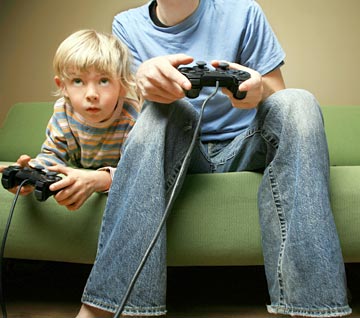Next generation gamers: Computer games aid recovery from stroke
Computer games are not just for kids. New research published in Journal of NeuroEngineering and Rehabilitation, a BioMed Central open access journal, shows that computer games can speed up and improve a patient’s recovery from paralysis after a stroke.
It is often difficult for stroke victims to recover hand and arm movement, and 80-90% of sufferers still have problems six months later. Scientists in America looked at a group of people who had impaired use of one arm after a stroke and found that computer simulations and cutting edge techniques, used by the film industry to produce computer generated action, could restore lost function.
While many current training regimes concentrate on regaining hand and arm movement separately, the computer games and robotic training aids used in this trial attempted to simultaneously improve function of both together. The games Plasma Pong and Hammer Task were used to improve hand/arm coordination, accuracy and speed, while the Virtual Piano and Hummingbird Hunt simulations helped to restore precision of grip and individual finger motion.
After training for two-three hours a day for eight days, all of the patients showed increased control of hand and arm during reaching. They all had better stability of the damaged limb, and greater smoothness and efficiency of movement. Kinematic analysis showed that they also had improved control over their fingers and were quicker at all test tasks. In contrast their uninjured arm and the arms of control game players, who had normal hand/arm function, showed no significant improvement at all.
Dr Alma Merians said, “Patients who played these games showed an average improvement in their standard clinical scores of 20-22% over the eight days. These results show that computer games could be an important tool in the recovery of paralysed limbs after stroke.”
###
Media Contact
Dr Hilary Glover
Scientific Press Officer, BioMed Central
Tel: +44 (0) 20 3192 2370
Email: .(JavaScript must be enabled to view this email address)
Notes to Editors
 1. Robotically Facilitated Virtual Rehabilitation of Arm Transport Integrated With Finger Movement in Persons with Hemiparesis
1. Robotically Facilitated Virtual Rehabilitation of Arm Transport Integrated With Finger Movement in Persons with Hemiparesis
Alma S Merians, Gerard G Fluet, Qinyin Qiu, Soha Saleh, Ian Lafond, Amy Davidow and Sergei V Adamovich
Journal of NeuroEngineering and Rehabilitation (in Press)
During embargo, article available here After embargo, article available at journal website
Please name the journal in any story you write. If you are writing for the web, please link to the article. All articles are available free of charge, according to BioMed Central’s open access policy.
Article citation and URL available on request at .(JavaScript must be enabled to view this email address) on the day of publication.
2. Journal of NeuroEngineering and Rehabilitation (JNER) is an open access, peer-reviewed online journal that aims to foster the publication of research work that results from cross-fertilization of the fields of neuroscience, biomedical engineering, and physical medicine & rehabilitation.
3. BioMed Central is an STM (Science, Technology and Medicine) publisher which has pioneered the open access publishing model. All peer-reviewed research articles published by BioMed Central are made immediately and freely accessible online, and are licensed to allow redistribution and reuse. BioMed Central is part of Springer Science+Business Media, a leading global publisher in the STM sector.